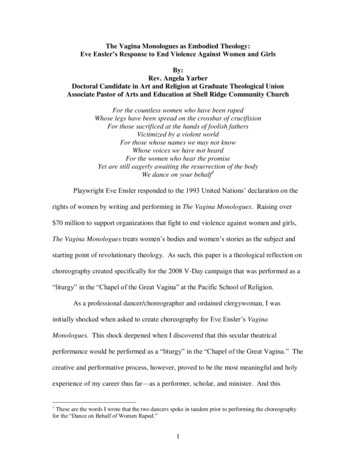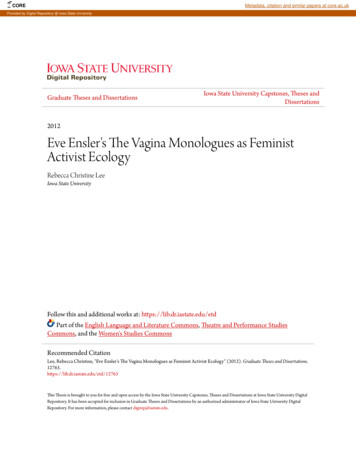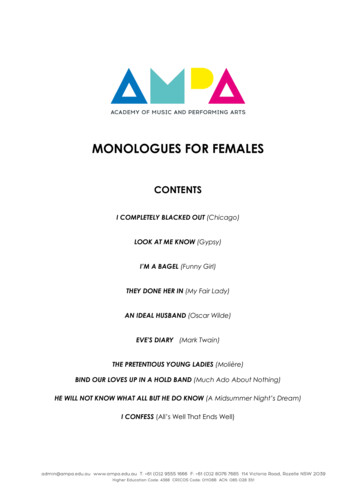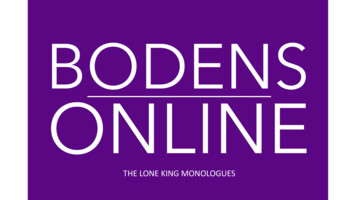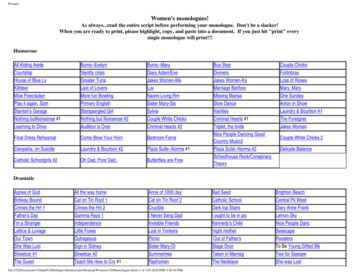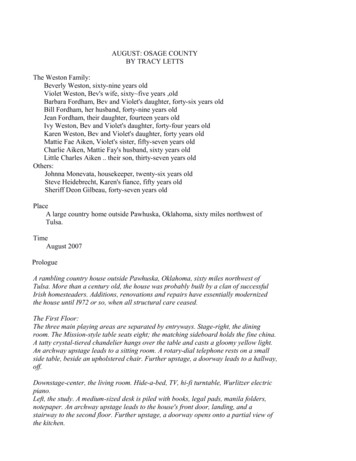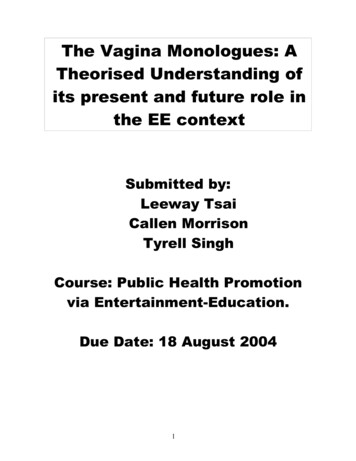
Transcription
The Vagina Monologues: ATheorised Understanding ofits present and future role inthe EE contextSubmitted by:Leeway TsaiCallen MorrisonTyrell SinghCourse: Public Health Promotionvia Entertainment-Education.Due Date: 18 August 20041
IntroductionEve Ensler’s play, The Vagina Monologues, addresses the issues of sexual violence anddisempowerment in a provocative, entertaining manner. The script is based on Ensler’sinterviews with over two hundred women about their personal experiences and includes topicssuch as genital mutilation, incest and rape. Although the play has been well received byaudiences in many countries, it has also generated a considerable amount of controversy. Theplay has spawned a grassroots movement, The V-Day Campaign, which aims to put an end toviolence against women and girls in the global context.The body of this paper is based on our observations and analysis of two performances of TheVagina Monologues in March 2004; one amateur, one professional. Semi-structured interviewswere also conducted with members of the professional and the amateur casts in order to gainfurther insight into, and understanding of, the topic. Entertainment-Education (EE) principlesand theories have been used as a basis for our assessment of the present and potential roles ofthe play in addressing the social problems it highlights.The analysis is particularly relevant to the South African situation in which rape and othersymptoms of female sexual disempowerment are widespread. As it has become understood thatthese factors also play a major role in the spread of HIV/AIDS, addressing the roots of theseproblems through effective health communication has become even more urgent. As a theaterpiece with the potential of empowering women in the sexual arena, The Vagina Monologueshas not only entertainment value, but also the possibility of being used as a vehicle for socialchange.In the body of this paper, the use of live theatre as a vehicle for EE and the way in which sociallearning theory can be applied to the play, will be explored. A comparative analysis of the twoperformances of the play will excavate the strengths and weaknesses of each approach. Finally,recommendations on the further use of The Vagina Monologues as an EE intervention will beuseful to those who may want to put on performances of the play in future or who may wish touse it in other violence against women campaigns in the South African context.2
Section 1: Background1.1) Sexual violence and disempowerment in South Africa.In South Africa, there is an unacceptably high prevalence of rape and sexual harassment. Sexfor women is often coercive and violent, and to some extent, this is accepted as the norm byboth genders (Delius and Glaser, 2002:27). Not only are violent sexual assaults emotionallyand psychologically damaging, they also make women more susceptible to HIV/AIDS, otherSTDs and pregnancy (Parker et al., 2000:3).According to Rape Crisis, there were 54 310 reported rapes, indecent assaults and incest casesin South Africa in 1998. At a conservative estimate, it is believed that only 1 in 20 cases isreported, thus the actual figure could be as high as 10 86200, which is 2976 rapes per day, ormore than two a minute. South Africa has the highest per capita rate of reported rape in theworld (115.6 for every 100 000 of the population in 1998). According to Vogelman and ationships(http://www.rapecrisis.org.za).Rape and sexual violence are an extreme example of the sexual disempowerment of women.However, women can be pressured by those who love them, and in situations which they couldavoid, or in which they could offer social, emotional, or physical resistance (Holland et al.,1992:9). In a male-dominated society such as ours, women are generally in a subservientposition to men, even in the context of a loving relationship. Although women may know therisks of unprotected sex, including HIV infection, taking control in sexual relationships can bedifficult if women play subordinate sexual roles. It has been argued that women who wish toensure their sexual safety (and their sexual pleasure) may have to be socially assertive, andpossibly, “unfeminine” as defined by their culture (Holland et al., 1992:1). Thus, in order to bein control of their sexuality, women may need to be prepared to lose a valued socialrelationship with a partner or potential partner.The ways in which gender ideologies are embedded in social and economic pressures can becomplex (Stanley and Wise, 1983 cited in Holland et al., 1992:4). In South Africa, two majorfactors have contributed to unequal sexual relationships and the spread of HIV/AIDS:3
transactional sex and poor negotiation skills in a sexual context. Researchers have noted thetransactional nature of sexual relationships in black South African society; in exchange for sex,girls expect their (often older) boyfriends to provide them with gifts, and even spending moneyand school-fees (Varga, 2000:53). Thus, poverty determines the expectations and structure ofsexual relationships, with women being forced to rely heavily on the sexual economy tosurvive. In addition, young women are thought to be especially vulnerable to HIV infectionbecause of their inability to negotiate the terms of sexual encounters (for example, Varga andMakubalo, 1996 in Varga, 2000:41). Condom use, for example, is related to factors like genderdynamics, sexual role stereotypes, the threat of physical violence, financial and materialconstraints and a lack of skills to challenge scripted sexual dynamics and partner expectations(Varga, 2000:44). Adolescent females do not talk about safer sex with their partners becausethey are worried about the possibility of emotional rejection, physical abuse, or being seen aspromiscuous or HIV positive (Varga, 2000:46).In the South African context particularly, the need for the sexual empowerment of women is,therefore, apparent. The question, then, is how. Holland and colleagues (writing in a moregeneral context) state that there is no language or model of positive female sexuality for youngwomen (1992:6). As discussed in later sections, The Vagina Monologues can fill this gap byserving as a powerful model of positive femininity and female sexuality. When young womenbecome sexually active and begin to test out their sexual identities, they do not have directpersonal experience to draw on, and information that could be helpful is usually not freelyavailable. The information that they do receive comes from a variety of often contradictorysources: childhood experiences, schools, parents and siblings, peers and the mass media(Holland et al., 1992:2). Thus, women have to make sense of contradictions in the socialconstruction of feminine sexuality (Ibid:3). They may have very little emotional or practicalinformation that can be used to define and negotiate the boundaries of their own pleasure orsafety (for example Thompson, 1984 in Holland et al., 1992:3).Holland et al. consider empowerment a process at the level of knowledge and ideas. Intellectualempowerment requires a model of positive female sexuality, which offers women a means ofreflecting critically on their own sexual experiences. Women are only victims when theirexperiences of coercive and/or violent sex appear to them as isolated personal experiences, for4
which they are responsible, and which they cannot prevent in the future. Intellectualempowerment, then, is a process of moving away from this way of thinking to a morecollective sense of women’s relationships to men. Experiential empowerment is a process ofputting into practice ways of negotiating safe and pleasurable sex with men (1992:23).Empowerment is not easily won, it is contested and a process in which women struggle tonegotiate with men to increase control over their own sexuality (Ibid:7). Positive female rolemodels like those in The Vagina Monologues can be helpful in showing women an alternativeway of engaging with their own feminine sexuality.1.2) The Vagina Monologues and the V-Day Campaign.It is daunting to think of the high rate of physical and emotional violence that women endurethroughout the world, regardless of ethnicity, nationality or education. Many women have tosuffer through various forms of violence at some point in their lives. Not only do the acts ofviolence need to be stopped, and the concept of inflicting violence on others eradicated, it isimperative that women are empowered, too, as the ultimate way of ending violence in the longrun. It is through empowerment, and the construction of self-worth, that women are able tohave the strength to stand up to violence.This section will give an overview of the rise of the play The Vagina Monologues, its rolewithin the V-Day organization (which has expanded globally), and some details of theworkings of the organization. V-Day is both a non-government and non-profit organization,established to help women envisage their sexuality with an open and empowered mind. Theorganization has initiated a series of awareness campaigns and events across the world since itsinception to achieve these aims.Eve Ensler’s play, The Vagina Monologues, served as the seed that gave rise to the V-Dayorganization. Ensler, author of The Vagina Monologues, founded V-Day in 1998 together witha group of women in New York. They all shared the same ideal of a world where women arefree from any form of violence. Ensler interviewed hundreds of women as backgroundinformation and inspiration for her play. During this process she realized that women across theglobe are constantly threatened by violence and abuse.5
The Vagina Monologues is a controversial piece due to its sexuality-oriented theme, witty yetexplicit script, and the often passionate and bold performances of the participating actresses.The play is comprised of a series of sketches, which centre on women and sexuality. Eachsketch consists of a story about a woman or a group of women whose sexual experiences bringchanges, pain, revelation or joy to their lives. The play can be seen as “a collection of women’svoices and speak[s] for other women” (Transcript 2:21). A number of social issues such asthe prevalence of sexual abuse of women are raised in these monologues, which are aimed atall social or cultural groups that make up the audience. The play can be very adequately viewedas a form of entertainment-education because it is indeed a “communication form with bothentertainment and education elements to enhance and facilitate social change” (Coleman,1999:76). As a part of the V-Day campaign, The Vagina Monologues provides entertainment,information, as well as serving as a potential source of empowerment for its audiences,particularly women and girls.After writing The Vagina Monologues Ensler realized that if people did not take more action toput an end to violence against women, it would continue to destroy lives. With this strongconviction, she established V-Day as a “global movement to end violence against women andgirls. It is also a catalyst that promotes creative events to increase rg/contents/vday/aboutvday). V-Day implements projects to raise theawareness of women’s rights as, in many parts of the world, these rights are still beingneglected or impinged on (for example, the issues surrounding female circumcision).Unlike most other non-profit organizations, V-Day does not have a physical location. It is runby several part-time and full-time staff in different parts of the world, and major projects thataim to stop violence against women are chosen annually. Many activists and volunteers haveoffered their time to initiate, organize and participate in V-Day events. This has allowed theorganization to gradually expand across the world. These events have also had support from,and participation by, many celebrities such as Jane Fonda, Glenn Close, and Oprah Winfrey.The V-Day campaigns and benefit performances of The Vagina Monologues attempt to provideemotional support and empower women and girls. It is hoped that audiences will then be betterequipped psychologically to deal with various kinds of gender-related discriminations. Women6
can learn to celebrate their sexuality rather than being ashamed, afraid or disgusted about it.The general public who attend the V-Day events are educated about the respect that women andgirls deserve.The activities and events of V-Day are not constrained to any particular location, and are heldat a variety of venues in many countries, ranging from stadiums, schools, to grass rootcommunity centers and spatially-intimate coffee-houses. These places usually offer a sense offamiliarity to the participants, allowing interaction to take place easily.Apart from the benefit performances of The Vagina Monologues, other V-Day initiativesinclude public service advertising campaigns; interactive V-Day events; and appealing toopinion leaders to use their advocacy to end violence against women. Knowing that theinfluence of grass root and community level activities are limited in terms of a wider nationalscale, V-Day has approached opinion leaders, such as “the Presidential candidates [of bothpolitical parties in America] urging them to make Violence Against Women a central issue s’issue”(http://www.vday.org/contents/vote). Public figures have the ability to exert a considerabledegree of influence over the public. Their authority and advocacy is thus a valuable resourcefor V-Day as most of its activities are designed to raise public awareness of a violence-freeworld for women.V-Day runs both College and Worldwide campaigns. Since 1999, more than one hundreduniversities and colleges globally have put on benefit productions of The Vagina Monologueson or around Valentine’s Day each year. Millions of people to date have been exposed to itsmessages. Students have the opportunity to be empowered during the process of activelyparticipating in and organizing the college campaigns, where they constantly engage with VDay’s philosophy of emancipating women from all types of sexual violence. As for theWorldwide campaigns, community members are encouraged to put on productions of TheVagina Monologues to help raise awareness of violence against women and to strengthenwomen’s sense of self-efficacy. The V-Day organization provides tools and guidelines onlinefor those who wish to organize a V-Day campaign.7
Both of the campaigns raise considerable sums of money through ticket sales of The VaginaMonologues performances and also from sponsorships and donations. The proceeds from VDay events are directed towards supporting women’s shelters and other organizations acrossthe world that work to terminate violence against women.1.3) Methodology.The major part of this project consists of a comparison between two local performances of TheVagina Monologues; one professional, one amateur. In order to analyze the two performancesin as much depth as possible, all three members of the research team attended eachperformance and took detailed notes on particular themes that had been discussed beforehand,as well as any other points that arose during the performances. Semi-structured interviews wereconducted with members of both casts in order to gain further insight into various relevantaspects of the performances (see appendix A).Before exploring the differences between the two performances of the play, however, it wasconsidered useful to apply Social Learning Theory and theories of live theatre to the script as awhole, in order to discover the ways in which The Vagina Monologues could work as an EEintervention. The comparative analysis of the two performances examines how each productionwas adjusted to appeal to the needs of different audiences, and shows that the modification ofdifferent elements can affect the way in which an intervention actually works.8
Section 2: Live Theatre as a vehicle for Entertainment Education, and inrelation to The Vagina MonologuesThe use of live theatre as a vehicle for Entertainment Education (EE) must conform to certainpre-existing theories of both of these concepts in order to be successful. An understanding oftheories of Dramatic Art as well as their correlation to the EE environment is fundamental inthe creation and production of an effective live theatre piece for an Entertainment Educationinitiative. For the purpose of this section, we will look at the medium of theatre, and TheVagina Monologues in four ways: As entertainment/art As an instrument of education As a weapon of social change As a document that reflects prevalent societal issues(Trumbull 2004)2.1)Theatre and The Vagina Monologues as forms of entertainment/art.Live theatre is a performing art. This classification sees the medium being viewed in light ofvarious theories in keeping with this genre. These include elements like the “production,performers, audience, director, theatre space, design aspects and text” (Wilson and Goldfarb,1999:12). It is also largely seen as being the embodiment of dramatic action in text, referring tothe script. On a more abstract level, theories of theatre as a performing art involve discussionson its ephemeral nature, and reflection and awareness of the now (Ibid).The notion of “the production” in dramatic theory deals with the overall manner in which theplay is portrayed to the audience. The way in which the script, lighting, music, direction andchoreography appear to the audience during the performance all form part of this theory.The professional and amateur productions of The Vagina Monologues differed in this regard for instance, the professional production contained several musical items while there was anabsence of music altogether in the amateur production. The two productions also differed interms of the lighting techniques employed. The professional production was marked by various9
changes in the lighting styles – single spotlights for the individual performances; dimmedlighting for one of the pieces, that reflected the subdued tone of that particular sketch; fulllighting for the musical performances. The amateur production used the theatre stage lights,which remained on throughout the entire performance.The effect of these theatrical and technical facets of The Vagina Monologues performancesleads to the conclusion that the medium of theatre is one that is easily adaptable to cater forvariations in context, whether it centers on type of production – professional and amateur - orthe actual textual elements of the performances.Productions are also often altered for the specific target audience they aim themselves at. In aproduction like The Vagina Monologues, where there was both a professional and amateurperformance, the specific tailoring of the show to context is an important element of theatre interms of the performing arts, when considering factors such as cost, target audiences amongothers. The specific tailoring of performances is likely to lead to the better reception of theproduction by the target audience.One of the prevailing questions is whether the “production” and “artistic” elements of livetheatre can appropriately lead to an education about a societal problem. The arts by nature havebeen known to distance themselves from any overt propaganda or stance.2.2) Theatre and The Vagina Monologues as instruments of education.The performing arts and theatre productions more specifically, have been used as instrumentsof education throughout their eras of existence. The appropriateness of the medium isembodied in the idea that the arts “help shape our perceptions (which comes through ouremotions, imaginations, and intellect) – in art experience is presented, not necessarilyexplained” (Cameron and Gillespie, 2004). It is, therefore, up to the audience to interpret and todecide whether the information and ideas that they are presented with are worth internalizingand incorporating into their individual worlds. This links to the idea of Participatory Theatre, a“strategic tool that envisages social and behavioral change. Community artists can selltheir own story, highlight their own concerns and develop their own strategies amongst10
themselves These public peer-to-peer statements are empowering in themselves. Andthe performances can then be addressed to a broader public or to those policy makers inthe wider world who have power over their lives” (Mavrocordatos, 2004).The use of the medium of theatre as an instrument of education is now more pronounced sincethere is added emphasis placed on Entertainment Education initiatives in contemporary society(Coleman, 1999:76).The Vagina Monologues aims to educate society about the prevalence of violence againstwomen worldwide, and create awareness on this subject through the performance of the storiesof actual women. The show educates in the nature of the pieces and the manner in which theyare performed. The overt, explicit and uninhibited performances (evident in both theprofessional and amateur productions) combined with the show’s powerful content, have thepotential to create a distinct awareness about violence against women and inform and educateto this effect as well.2.3) Theatre and The Vagina Monologues as weapons of social change.The concept of theatre being a medium for social change links with its educational qualities.Seen in this light, it is usually the information contained in a performance- that is how iteducates an audience- that leads to any social change. There are also other elements such asobservational learning, which will be discussed in later sections.The Vagina Monologues aims to initiate social change against women’s abuse. The medium oftheatre is an often forgotten means of communicating important issues, but nevertheless can actas a powerful form of health communication. Live theatre is largely seen as a more intimateway of engaging with an audience than many other mass media forms. Cast members of theprofessional production pointed out that other media, due to their mass exposure in society,may have a desensitizing effect regarding the audience’s views of the issues of abuse againstwomen (Transcript 1:43-46).The medium of live theatre facilitates interaction between the performers and audience. In bothperformances of The Vagina Monologues, this served to heighten the effect of the already11
controversial issues touched on, in that the audience was at times incited into some kind ofaction then and there – whether verbal or by showing a group consensus in standing up if theyhad been abused themselves, or knew anyone who had been abused. This type of effect couldnever have been achieved using any other medium. As will be discussed later, however, variousfactors can affect the level of interaction between cast and audience, and these differences werepronounced in the two performances analyzed.2.4) Theatre and The Vagina Monologues as a document that reflects prevalent societalissues.The theatre has traditionally been used to portray historical events or to reflect prevalent issuesof society at that particular time. These performances serve as documents of history, and add tothe history of the world. Examples of this include Shakespeare’s Julius Caesar and Anthonyand Cleopatra; both explorations into the real history of the world.The Vagina Monologues may be seen as enforcing the above idea, as it is a reflection of aprevalent societal occurrence. The play is also not a new one. It was in fact written in the1980s, yet has only been exposed to audiences recently. This shows that the issue ofdocumenting history and trying to change the future, regarding women’s abuse, has beenattempted for quite some time. Contemporary society, though, provides a somewhat easierplatform for issues of this kind to be given attention, and the medium of the theatre provides aneffective stage.2.5) The Vagina Monologues and Action Media.The Vagina Monologues links to theories of Participatory Theatre as well as Action Media.Action Media is defined as being “a methodology for the development of media products thatintegrates the interests of both the communicator and representatives of target audiences withina health promotion context” (Parker, 1997:54). Parker goes on to state:“The Action Media approach involves a process that allows for integration ofperspectives of representatives of target audiences – a process that allows for deepreflection around issues that affect their lives – and a process that allows for the12
incorporation of linguistic and cultural perspectives relevant to the target audience. Thisallows message development to become an organic process. The methodology is suchthat it engenders action amongst the participants and this impetus can be harnessed insubsequent activities at the individual, group, or local community level” (Parker1997:56).Using the above definitions (and as will be discussed in more detail later) it is evident that theamateur performance of The Vagina Monologues can be viewed as being part of the ActionMedia theories in Entertainment Education more so than the professional performance. This isdue to a number of different elements including that the amateur actresses seemed much moreinvolved in making The Vagina Monologues real to themselves and their audience; thusempowering and educating themselves while doing the same to others.Eve Ensler’s original concept, though, does fit in with Action Media in that it “brings togetherthe imperatives of the communicator on the one hand and readers on the other” (Parker,1997:57). Her vision combined with the real experiences of the women she interviewed led tothe creation of The Vagina Monologues, thus possibly making the play more relevant andpowerful than a purely fictional piece, or one based only on the author’s experiences.13
Section 3: Social Learning Theory and The Vagina MonologuesAs discussed in the previous section, live theatre has the capability of effecting social changes,whether intentionally or inadvertently. Social change is a collective effort, and every individualmatters. For this research, we have chosen to look at Social Cognitive Theory or SocialLearning Theory in explaining the effectiveness of The Vagina Monologues in influencingindividuals’ thoughts and behavior towards specific social issues, particularly those pertainingto women and sexuality. Application of this theory allows an understanding of how the play,through providing vicarious learning experiences for the audience, can serve as a potential“weapon of social change”.5.1) Social Learning Theory.In the 1970’s, Albert Bandura developed Social Cognitive Theory, a sophisticated and complexframework for understanding human behavior. Also known as Social Learning Theory (SLT),the concept is currently the dominant behavior change model used in the field of healthcommunication (Glanz and Rimer, 1995:22) and is also widely applied to the field ofEntertainment-Education (Coleman, 1999: 76). This theory is based on theories of modelingand vicarious learning, which contend that “new responses are acquired, reinforced, orextinguished, at a distance (vicariously), through observation of the behavior of others”(Sheldon, 1982:73). Social Learning Theory is an interpersonal theory and thus it states that noindividual carries out a behavior in a vacuum; individuals exist within social environments inwhich other people’s actions, attitudes and emotional support affect their own feelings, andbehaviors (Ibid). People are both influenced by and influential in their social environments.Social Learning Theory consists of a number of key constructs. These include: Observational learning: observational learning is one of the most importantcomponents of this theory and refers to the ability of an individual to learn based onobserving others. Processes governing observational learning are: attention (gaining andmaintaining attention), retention (being remembered), production (reproducing theobserved behavior) and motivation (being stimulated to produce the behavior)(Lefebvre, 2001:509). This process is also called modeling because people learn what toexpect through watching the experiences of others (Glanz and Rimer, 1995:24).14
Individuals can learn something about the likely consequences of their actions byobserving others and seeing whether the modeled behaviors are desirable or not(Ibid:24). The role of observation in changing behavior is most significant when theperson being observed is powerful, highly respected or seen to have similarities to theobserver (Ibid). Observational learning is particularly important in the process ofsocialisation and in learning the rules of correct behavior in society (Goldstein,1994:266). Reciprocal determinism: reciprocal determinism implies that behavior, cognitive andother interpersonal factors, and environmental events all operate as interactingdeterminants of each other (Lefebvre 2001:509). Figure 1 illustrates the concept ofreciprocal determinism:BehaviorEnvironmentCognitive andInterpersonalfactorsFigure 1) Diagram illustrating reciprocal determinism. Behavioral capability: behavioral capability is the knowledge and skills that anindividual needs to possess in order to behave in a certain way (Ibid). Expectations: expectations are an individual’s beliefs about the probable results of aparticular behavior (Ibid).15
Self-efficacy: self-efficacy is the confidence that an individual has in his/her ability totake action and remain committed to that behavior (Ibid). Reinforcement: reinforcement-either positive or negative-can be defined as those socialor environmental responses to an individual’s behavior that either increase or decreasethe likelihood of the behavior being performed again (Ibid:23).In contrast to many behavior change models, this
The Vagina Monologues is a controversial piece due to its sexuality-oriented theme, witty yet explicit script, and the often passionate and bold performances of the participating actresses. The play is comprised of a

